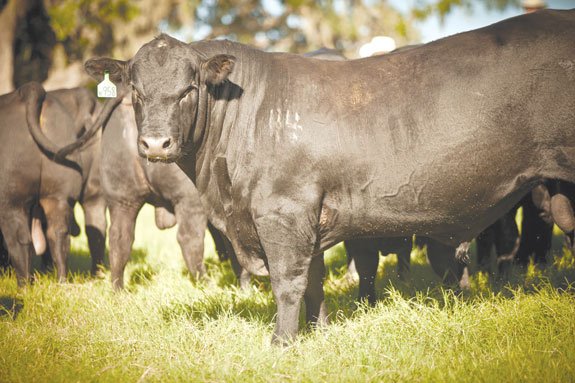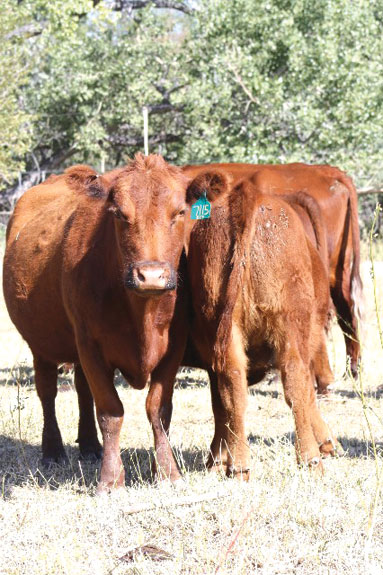Heifer development and bred heifer sales hold the attention of producers eager for herd growth and hopeful for a good grass crop.
Three registered Angus breeders of varying size and scope offer their unique perspectives on how to rebuild and whether now, indeed, is the time.
Brand of Choice /Lone Star Angus Alliance
Mr. and Mrs. E. M. Holt
Weimar, Texas
In over 60 years of raising registered Angus cattle in central Texas, E. M. Holt has endured all that lies between grueling droughts and generous floods.
Holt and his wife, Nancy, sell bulls and females in cooperation with the Lone Star Angus Alliance to local ranchers, most living within 150 miles.
A seasoned observer of volatile cattle markets and their aftermath, he has consequently learned to stay “in the middle of the road” and has avoided fickle trends.
Although herd reduction has become the predictable drought survival mechanism for Texas cattle producers, Holt forecasts a very slow rebound compared to past recoveries.
Holt’s operation, Brand of Choice, exists in the center of a highway triangle that interconnects Houston, San Antonio and Austin.
Development, subdivision and annexation have thrust land value and taxes higher.
“People are very hesitant to enter the [cattle] business because the costs are so high upfront,” reports Mrs. Holt.
During the Lone Star Angus Alliance’s recent sales, Mr. Holt observed that “the crowd was aging.”
He added that much of Texas ranchland is remotely owned by urban dwellers. These customers “cannot be present for every calf delivery.” He suggests they buy a second-calf cow. His bred heifer sales with the Alliance remain good.
The operation uses bulls on half their herd and AIs the rest with known heat tolerance and efficiency phenotypes.
“We AI from bulls with additional qualities that complement what our bulls have,” Holt elaborates. “Our herd bulls are AI-sired and out of proven Pathfinder cows.” Brand of Choice tries to remain self-sufficient on forage resources.
Last year, Holt irrigated, fertilized and cut his hayfields until he filled the barn. He then subdivided his hayfields into paddocks and rotated his cattle through daily.
Holt supplements when needed to preserve his genetics and especially to maintain his developing bulls and heifers.
Despite the threats from rising taxes, depleted hay reserves and capricious weather, Holt is still confident that eventually “supply and demand will stabilize the [U.S.] cattle herd,” perhaps just as it always has.
44 Farms
Doug Slattery
Cameron, Texas

Doug Slattery, chief operations officer of 44 Farms in Cameron, Texas, observed a short-term recovery this spring from “the worst drought in history.”
However, he believes people are still in a defensive mode. “Nobody is confident that the drought is over.”
Still, he adds, “There is good market optimism.” The spring cattle sale fared better than anticipated, likely due to high calf prices.
He noticed people bid higher for fewer bulls and heifers – “most people focused on quality, not quantity.” This year, 900 bulls received new homes.
Interest in both open and bred females this year especially accumulated out of state, with bids sourcing from California to North Carolina.
“Not for Texas. They are not building there,” commented Slattery, since moisture has remained low for the region. “It will be a slow process.”
Slattery predicts the greatest challenge for those rebuilding is the cost of cattle, with fuel and feed costs posing a secondary challenge.
At 44 Farms, cattle managers rely on genetic efficiency and keep their feed regimen flexible according to the most economical commodity selection.
Last year, 44 Farms contracted a slew of gin trash and ground cotton burr, which they mixed with liquid feed and corn as needed.
They grow and cut coastal, common and Tifton 85 bermudagrasses, as well as native grasses.
While last year’s weather induced a 50 percent decrease in heifer sales, 44 Farms is busily planning this fall’s female sale with plenty of optimism.
As they develop heifers, Slattery’s team breeds heifers at 14 to 15 months so they calve at 24 months.
He adds, “Early puberty is one great advantage with Angus,” which typically begin cycling at 10 months. The operation sells about three times more bred females than open females.
They anticipate sales of 200 registered females and 300 commercial females this fall.
Thankful for 44 Farms’ consistent teamwork and success, Slattery offers wisdom on toughing out the lean times: “Keep the stocking rates low. It’s easy when grass is green to overstock.”
K2 Red Angus
Kim Cullen
Wheatland, Wyoming

This year, Kim Cullen of Wheatland, Wyoming will help satisfy demand for bred heifers to restock the South.
She will accomplish this while at the same time preparing for her annual Red Angus Internet bull sale, running her custom AI business and representing Genex as a sales professional.
Cullen and her family manage a heifer development operation that is preparing for a task of national proportions.
Southeastern Wyoming provides an ideal environment for developing heifers. Cullen explains, “We have enough feed to grow heifers but not enough feed to finish cattle and compete with our neighbors to the east.”
All of the feedyards in Cullen’s region focus on heifer development for that reason. Tough winters and highly digestible summer grass have persuaded many highland producers to send heifers east to Wheatland “where the weather is milder, the feed is available and the cattle can be grown and wintered at a manageable cost.”
In Wheatland, heifers arrive in the fall and graze down the alfalfa, corn and oat stubble. They consume stored crops through the winter and in early spring enter drylots where they are synchronized.
In late spring, these cattle are then AI’ed and returned to the mountains to enjoy the summer’s bounty.
At her own operation, K2 Red Angus, Cullen lets her weanling heifers back out on the range with the cows.
“I believe this teaches the heifers to learn to graze with the cows and it also starts putting the selection pressure on them so that only the efficient females that are adapted to this environment will make it into the herd.”
Cullen requires that cattle be “functional, fertile and efficient.” She inspects udder, foot and leg structure and avoids genetics that will lower the quality of these traits.
“My cattle must be efficient and run in the harsh range conditions in the foothills of southeastern Wyoming – where rocks and cactus are more common than a good blade of grass.”
They must also conceive each year in about a 50-day calving window, with “absolutely no excuses.”
Of the Texas drought impact, Cullen remarks, “We had more heifers being set up to be bred this year, with the expectation of restocking going on in the Texas drought areas.”
The guidance she offers to those rebuilding is to “have their goal in mind. What type of cattle do they want or need to fit their operation, resources and environment?
Whatever genetics they choose to restock the herd will be long-lasting into the future and the results will have a huge part in determining the success or failure of the operation.” ![]()
PHOTO
TOP: In last year’s drought, Brand of Choice owner E. M. Holt cut hayfields then subdivided them into paddocks and rotated his cattle through daily. Photo courtesy of Lone Star Angus Alliance.
MIDDLE: The cycle of Angus cows helps 44 Farms of Cameron, Texas, sell about three times more bred females than open females. Photo courtesy of 44 Farms.
BOTTOM: Allowing weanling heifers onto grass with cows makes transition easier for future adaptability at K2 Red Angus. Photo courtesy of K2 Red Angus.






